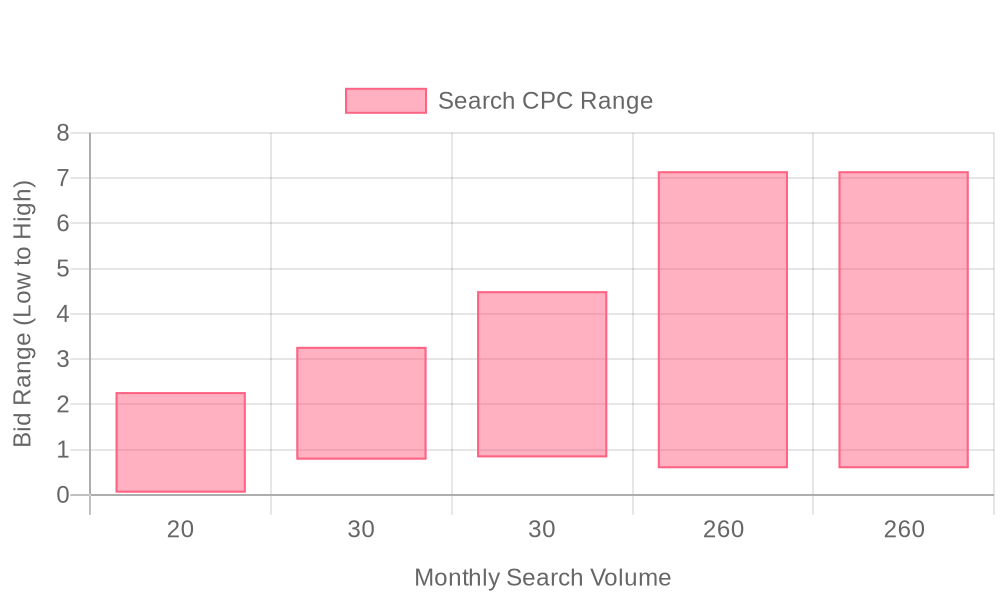
Supercharge your lead generation with a FREE Google Ads audit - no strings attached! See how you can generate more and higher quality leads
Get My Free Google Ads AuditFree consultation

No commitment
Supercharge your lead generation with a FREE Google Ads audit - no strings attached! See how you can generate more and higher quality leads
Get My Free Google Ads AuditFree consultation

No commitment
In today's marketing landscape, Google Ads presents a key opportunity for diet food retailers aiming to reach health-conscious consumers with precision. As dietary preferences become more complex and varied, traditional advertising channels alone often fall short in engaging potential customers who are actively searching for specific diet food solutions. Google Ads effectively bridges this gap, offering targeted ads at the exact moment potential buyers are searching online. For diet food retailers, Google Ads unlocks the ability to capture high-intent customers, enabling seamless integration between online promotions and offline retail or delivery services. However, the challenge often lies in missing high-value prospects or failing to engage anonymous visitors—issues that can lead to lost opportunities and a lower return on investment. This guide outlines the essential strategies to optimize Google Ads for diet food retail, ensuring that every advertising dollar spent translates into measurable ROI.

Diet food retailers operate in a market where high-intent buyers expect both relevance and authenticity from every digital interaction. Modern Google Ads strategies for this sector demand a blend of niche targeting, dynamic audience segmentation, and agile campaign management to convert health-conscious consumers. By leveraging unified data and advanced insight tools, B2B revenue teams can move beyond surface-level metrics and achieve sustainable lead generation at scale. To stay updated on the latest strategies, visit the Sona blog.
Today’s healthy food marketers must distinguish their offerings in a crowded landscape through precise keyword targeting, real-time audience enrichment, and seamless CRM integration. With technology enabling deeper visibility into buyer intent and journey stages, advertising spend can be directed toward prospects most likely to convert, driving higher ROI and stronger market share for dietary product promotion.
Diet food retailers operate within a market defined by fast-changing consumer preferences, dietary trends, and high-value purchase cycles. Google Ads offers a direct channel to reach nutritionists, home chefs, and health-focused shoppers, leveraging granular audience segmentation to match ads with in-market buyers seeking specialized diet solutions. By enriching audience data, marketers can move beyond anonymous web traffic, identifying not just generic visitors but high-potential companies and individuals who are actively evaluating dietary products.
High-value transactions such as premium meal kits and specialty health snacks demand strategic budget allocation. By focusing ad spend on segments with proven purchase intent, retailers avoid wasted impressions and elevate campaign efficiency. With advanced analytics and unified data integration, teams can prioritize high-value prospects, dynamically updating audience segments as leads move through the funnel and ensuring that advertising investments consistently target the most promising accounts.
Diet food retail is highly responsive to seasonal trends, new diet movements, and shifts in consumer sentiment. Google Ads empowers retailers to react in real time, capturing surges in demand around events like New Year’s resolutions or trending diets, and adapting creative based on live intent signals. Enhanced visibility into visitor behavior and intent data enables teams to swiftly reallocate budget toward high-converting accounts, while robust attribution connects every click and conversion—whether online or offline—back to its true source, providing actionable intelligence for future campaign optimization. For more on how dietitians can leverage this platform, see best practices for dietitians using Google Ads.
Integrating Google Ads with unified analytics and CRM platforms further enhances campaign performance. By syncing enriched leads and audience data into downstream systems, teams ensure that every prospect who expresses interest receives consistent, personalized follow-up across email, sales outreach, and remarketing. This level of orchestration transforms online advertising for diet foods from isolated tactics into a cohesive, data-driven strategy that powers measurable revenue growth and long-term customer loyalty. Get started for free with Sona.

Ready to upgrade your diet food ad campaigns? Get started for free with Sona.
Diet food retailers can accelerate growth by moving beyond crowded, generic channels and pursuing targeted strategies that capture demand from health-focused and specialty diets. Focusing efforts where high-intent audiences already gather, such as specialized forums or niche search queries, unlocks new revenue streams and minimizes wasted ad spend. Explore more insights on account-based marketing for go-to-market teams to refine your audience targeting strategy.
By combining these strategies and unifying audience, intent, and conversion data, diet food retailers can consistently uncover and capitalize on growth opportunities in a competitive market. This data-driven, dynamic approach ensures that marketing investments are aligned with actual buyer behavior, fueling sustainable business expansion. To experience these capabilities firsthand, get started for free with Sona and unlock your next phase of growth.
Diet food retailers succeed when every advertising dollar reaches the consumers most likely to buy. Audience segmentation ensures marketing messages are hyper-relevant, improving conversion rates and reducing wasted spend in a highly competitive market. For a deeper dive into strategies that help gluten-free and keto-friendly brands reach niche audiences, see this Google Ads guide for specialty food brands.

| Industry | Keyword | Monthly Search Volume | Competition Level | Low Bid | High Bid |
| Diet Food Retailers | science diet pet supermarket | 20 | MEDIUM | 0.05 | 2.27 |
| Diet Food Retailers | keto groceries near me | 30 | HIGH | 0.78 | 3.27 |
| Diet Food Retailers | science diet retail | 30 | HIGH | 0.83 | 4.5 |
| Diet Food Retailers | healthy food at sam's club | 260 | HIGH | 0.59 | 7.15 |
| Diet Food Retailers | healthy food sam's club | 260 | HIGH | 0.59 | 7.15 |
B2B revenue teams in the diet food retail space succeed when their keyword strategy is driven by specificity, intent, and continuous refinement. Precise targeting of high-value, dietary-focused terms ensures that ad budgets are invested in audiences actively seeking solutions, minimizing wasted spend and maximizing qualified lead flow. For additional strategic insights, explore Google Ads strategies for gluten-free and keto brands.
When advanced platforms are layered into this process, marketers move beyond basic keyword matching. Visitor identification bridges the gap between anonymous traffic and actionable lead data, allowing teams to recognize which companies or decision-makers are engaging with diet food ads. Real-time audience updates further refine targeting by flagging high-value accounts as they show in-market activity, enabling on-the-fly budget shifts toward the audiences most likely to convert. As leads progress through the funnel, dynamic audience updates ensure that retargeting pools remain fresh and relevant. Seamless CRM and ad platform sync lets marketers deploy enriched audiences and conversion data back into Google Ads, maintaining a closed feedback loop that drives both precision and scale. This holistic approach empowers B2B diet food retailers to systematically outpace generic healthy food marketing strategies and maximize the impact of every advertising dollar. Ready to optimize your campaigns? Get started for free with Sona.
Effective campaigns for diet food retailers begin with the careful selection of niche and long-tail keywords reflecting real consumer search intent. By leveraging advanced data insights and competitive analysis, marketers can pinpoint high-value phrases such as “gluten-free meal delivery,” “healthy snack subscriptions,” or “keto-ready meals near me.” This approach ensures that ad spend is concentrated on queries most likely to convert, reducing waste and increasing relevance. The use of real-time audience data enables continual refinement, allowing teams to quickly capitalize on emerging trends and shifts in customer demand.
Connecting keyword research directly with first-party data sources creates a feedback loop, helping marketers adjust their lists as audience behaviors and market conditions evolve. For example, as new dietary trends or product categories gain traction, enriched insights surface fresh keyword opportunities. For deeper insights into ROAS benchmarks for ready-to-eat meal companies, refer to industry ROAS benchmarks. This dynamic alignment ensures diet food advertising remains agile and competitive, targeting high-intent consumers as they enter the market.
Ad copy is the frontline of diet food promotion, so it must be both persuasive and compliant with industry standards. Addressing the pain points of health-conscious consumers—such as convenience, ingredient transparency, and nutritional value—establishes immediate relevance. Action-driven language and urgency-inducing calls to action, like “Order today for free shipping” or “Limited-time healthy meal offers,” can significantly lift response rates. By analyzing buyer journey data, ad messaging can be tailored to engage users at each phase, from awareness to conversion.
AI-enhanced modeling identifies the motivators unique to each audience segment, guiding copy adjustments in real time. As a result, advertisers can pivot messaging based on in-market behavior, delivering the right promise to the right customer at the right moment. This approach increases engagement and ensures that Google Ads for Diet Food Retailers consistently outperform generic food marketing campaigns. For additional tips, explore this step-by-step guide for dietitians to generate leads with targeted Google Ads.
Landing pages must deliver a seamless, relevant experience that aligns perfectly with the promise of the ad. For diet food retailers, this means designing mobile-optimized pages that showcase product benefits, nutritional information, and strong calls to action. Clear navigation and fast load times are critical, as health-focused shoppers are quick to abandon slow or confusing pages. Each landing page should be tightly linked to specific ad groups, reinforcing the message that brought the visitor there.
Integrating enriched audience insights into landing page personalization further boosts conversion rates. For example, returning visitors can be shown tailored offers or educational content based on their previous on-site actions. Learn how health food stores can optimize Google Ads to grow their local customer base in this digital marketing guide. This level of relevance not only improves immediate sales but also builds long-term loyalty among health-conscious consumers.
Success in online advertising for diet foods relies on a relentless commitment to optimization. Modern teams utilize advanced feedback loops, drawing on enriched real-time intent signals to continually test and refine ad creative, audience segments, and bidding strategies. Automated attribution models track both online and offline interactions, delivering a comprehensive view of true campaign ROI and highlighting high-performing channels or audience groups.
As leads move through the funnel, dynamic audience lists are updated and synced across marketing platforms, ensuring retargeting and nurture flows remain accurate. CRM integration enables seamless syncing of enriched leads and purchasing signals directly into Google Ads and sales platforms, driving timely follow-up and better attribution. This unified approach eliminates data silos, allowing revenue teams to reallocate budget to the highest-converting audiences and optimize diet food retail marketing for both acquisition and retention. Get started for free with Sona.
Bringing your diet food products to a wider audience requires a blend of precise targeting, audience insight, and agile campaign execution. Success in this category depends on your ability to address the unique purchase drivers of health-conscious consumers while leveraging real-time data to inform every marketing move.
For teams looking to scale their data-driven approach, get started for free with Sona.
In conclusion, leveraging Google Ads effectively can significantly enhance the visibility and reach of your diet food products to health-conscious consumers. By understanding the nuances of your target audience and employing strategic advertising approaches, you can maximize your ad spend and drive meaningful engagement.
Throughout this article, we've explored the core challenges diet food retailers face in digital advertising, such as targeting the right demographics and creating compelling ad content. We've discussed best practices, including using specific keywords, crafting engaging ad creatives, and optimizing landing pages to convert clicks into customers.
The potential for transformation in your advertising efforts is immense. By applying these insights, you can position your brand as a leading choice for consumers seeking healthy dietary options. Embrace these strategies, and you'll be well on your way to achieving advertising success and business growth.
To truly harness the power of these insights and streamline your advertising strategy, start for free to experience our platform and its capabilities today.
The best strategies include precise keyword targeting, dynamic audience segmentation, and agile campaign management to convert health-conscious consumers.
Retailers can target consumers by using niche keywords, real-time audience enrichment, and CRM integration to ensure ads reach high-intent prospects.
Budgets should focus on segments with proven purchase intent, dynamically shifting to high-converting accounts to maximize ROI.
Keywords such as 'vegan snacks,' 'keto meal delivery,' and 'gluten-free meal kits' should be prioritized to reflect consumer intent.
Common mistakes include missing high-value prospects, failing to engage anonymous visitors, and not aligning ad copy with landing page content.
Join results-focused teams combining Sona Platform automation with advanced Google Ads strategies to scale lead generation

Connect your existing CRM

Free Account Enrichment

No setup fees
No commitment required

Free consultation

Get a custom Google Ads roadmap for your business
Join results-focused teams using Sona Platform automation to activate unified sales and marketing data, maximize ROI on marketing investments, and drive measurable growth

Connect your existing CRM

Free Account Enrichment

No setup fees
No commitment required

Free consultation

Get a custom Google Ads roadmap for your business
Over 500+ auto detailing businesses trust our platform to grow their revenue
Join results-focused teams using Sona Platform automation to activate unified sales and marketing data, maximize ROI on marketing investments, and drive measurable growth

Connect your existing CRM

Free Account Enrichment

No setup fees
No commitment required

Free consultation

Get a custom Google Ads roadmap for your business
Over 500+ auto detailing businesses trust our platform to grow their revenue
Join results-focused teams using Sona Platform automation to activate unified sales and marketing data, maximize ROI on marketing investments, and drive measurable growth

Connect your existing CRM

Free Account Enrichment

No setup fees
No commitment required

Free consultation

Get a custom Google Ads roadmap for your business
Over 500+ auto detailing businesses trust our platform to grow their revenue
Join results-focused teams using Sona Platform automation to activate unified sales and marketing data, maximize ROI on marketing investments, and drive measurable growth

Connect your existing CRM

Free Account Enrichment

No setup fees
No commitment required

Free consultation

Get a custom Google Ads roadmap for your business
Over 500+ auto detailing businesses trust our platform to grow their revenue
Our team of experts can implement your Google Ads campaigns, then show you how Sona helps you manage exceptional campaign performance and sales.
Schedule your FREE 15-minute strategy sessionOur team of experts can help improve your demand generation strategy, and can show you how advanced attribution and data activation can help you realize more opportunities and improve sales performance.
Schedule your FREE 30-minute strategy sessionOur team of experts can help improve your demand generation strategy, and can show you how advanced attribution and data activation can help you realize more opportunities and improve sales performance.
Schedule your FREE 30-minute strategy sessionOur team of experts can help improve your demand generation strategy, and can show you how advanced attribution and data activation can help you realize more opportunities and improve sales performance.
Schedule your FREE 30-minute strategy sessionOur team of experts can help improve your demand generation strategy, and can show you how advanced attribution and data activation can help you realize more opportunities and improve sales performance.
Schedule your FREE 30-minute strategy session





Launch campaigns that generate qualified leads in 30 days or less.
